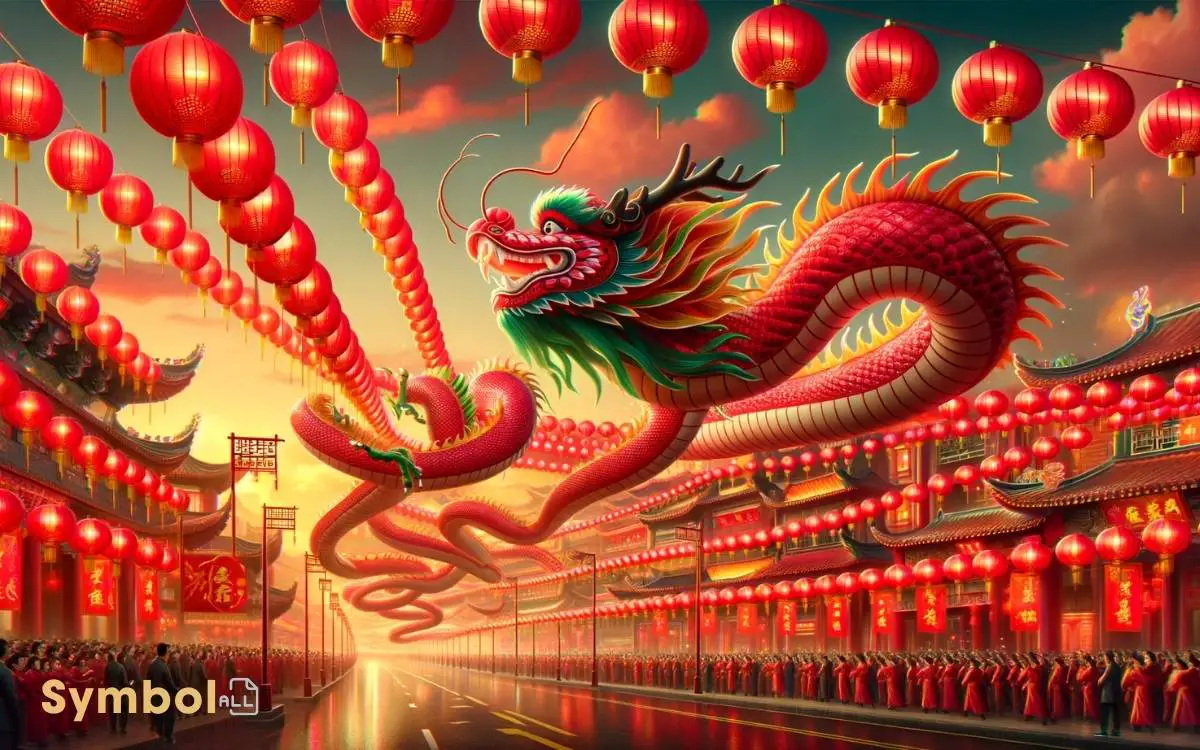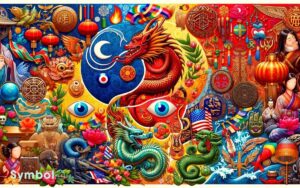What Does the Color Red Symbolize in China? Prosperity!
In China, you’ll find that red isn’t just a color—it’s a symbol of prosperity, happiness, and good fortune.
Historically, red marked the emperor’s power and has always been a sign of protection and balance, thanks to its connection with fire in the Five Elements Theory.
During festivals like Chinese New Year, red decorations and attire ward off evil spirits and bring good luck. It’s a staple at weddings too, radiating love and joy.
Beyond celebrations, red envelopes during sales events and digital transfers signify wealth and success. It’s a powerful emblem throughout Chinese society, blending tradition with modernity.

Key Takeaway
Historical Significance
Throughout history, red has played a pivotal role in Chinese culture, symbolizing prosperity, happiness, and good fortune. This color’s significance is deeply rooted in ancient beliefs and philosophical ideals.
In dynastic times, red was the exclusive color of the emperors, representing power, authority, and divine favor. Its use in imperial seals and dragons denoted supreme control and protection.
Additionally, red’s association with fire in the Five Elements Theory underscores its importance in balancing harmony and warding off evil spirits.
This enduring symbolism reflects in architecture, with red being prominent in historical landmarks, signifying protection and cultural continuity.
Understanding red’s historical significance offers you a deeper insight into its pervasive presence and revered status in Chinese tradition, beyond mere aesthetics.
Cultural Celebrations
Red’s vibrant hue takes center stage in numerous Chinese cultural celebrations, embodying joy, prosperity, and communal unity.
This color’s significance is deeply rooted in traditions and rituals that date back centuries, offering a rich tapestry of cultural heritage that continues to thrive today.
- Chinese New Year: A festival awash in red, from lanterns to envelopes, symbolizing good luck and warding off evil spirits.
- Weddings: Red dominates wedding attire and decor, representing love, happiness, and a prosperous future for the couple.
- Dragon Boat Festival: Red adorns boats and participants’ clothing, evoking the energy and strength of the community.
These celebrations showcase red’s pivotal role in not just honoring the past but also in nurturing a sense of belonging and togetherness among people, reinforcing its timeless relevance in Chinese culture.
Symbol of Prosperity
In Chinese culture, red not only symbolizes joy and unity but also stands as a powerful emblem of prosperity, deeply influencing the economic and social fabric of society.
This color’s association with wealth and success isn’t accidental; it’s rooted in historical beliefs and practices that view red as auspicious and capable of attracting good fortune.
You’ll see businesses adorned in red during important sales events and festivals, believing it’ll usher in wealth and prosperity.
Additionally, red envelopes, filled with money and given during celebrations, embody this symbolism directly, acting as a conduit for transferring wealth and good wishes.
This practice underlines a communal aspiration towards economic well-being, showcasing how deeply intertwined red is with the pursuit of prosperity in Chinese society.
Political Meanings
Beyond its cultural and economic significance, red also embodies profound political meanings within Chinese society, signaling power, authority, and communist ideology.
Since the founding of the People’s Republic of China in 1949, red has been prominently featured in flags, banners, and national emblems, cementing its role as a symbol of the state’s power and governance.
- Red evokes a sense of solidarity among the people, uniting them under a single banner of socialism.
- It’s a reminder of the revolutionary spirit that led to the formation of modern China.
- The color inspires a deep feeling of national pride and loyalty to the communist ideals.
Analyzing red’s political symbolism provides insight into how deeply intertwined color can be with a nation’s identity and political philosophy. Historically, the color red has been associated with revolution, socialism, and communism, representing themes of equality, struggle, and power. From national flags to political movements, the color red symbolism explored reveals its capacity to evoke emotion and unity among its supporters. Its vibrant and attention-grabbing nature continues to make it a dominant force in political branding and messaging worldwide.
Modern Interpretations
Today’s evolving societal norms have reshaped the interpretation of red, merging its historical significance with contemporary values and perspectives.
In modern China, red isn’t just a symbol of luck and prosperity; it’s also become emblematic of the country’s rapid economic growth and the vibrancy of its pop culture.
You’ll see it pulsating through the neon lights of Shanghai’s skyline, representing both the traditional and the cutting-edge.
Red envelopes, once solely a New Year custom, now also circulate digitally, illustrating how tradition adapts to modern technology. Yet, amidst this evolution, the color retains its deep-rooted meanings.
It’s a demonstration of how cultures can evolve while honoring their heritage, allowing red to symbolize both the past’s reverence and the future’s promise.
Conclusion
To conclude, you’ve witnessed how red surpasses mere color in China, embodying historical depth, cultural vitality, prosperity, and political power. It’s not just a hue; it’s a narrative of endurance, celebration, and ambition.
This exploration reveals red as more than tradition—it’s a dynamic symbol shaping modern Chinese identity.
By understanding its multifaceted significance, you grasp not just a color, but a vibrant thread woven into the fabric of China’s past, present, and future.






